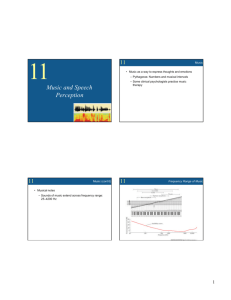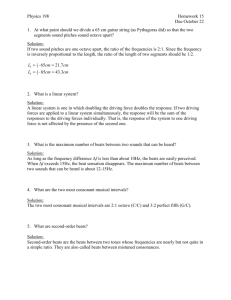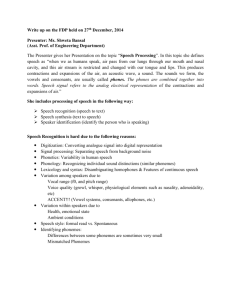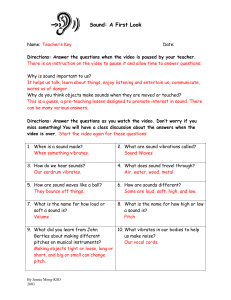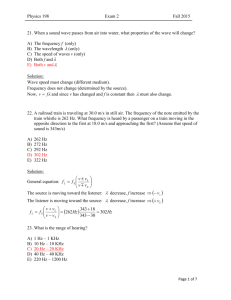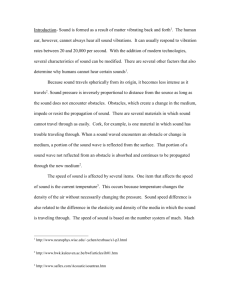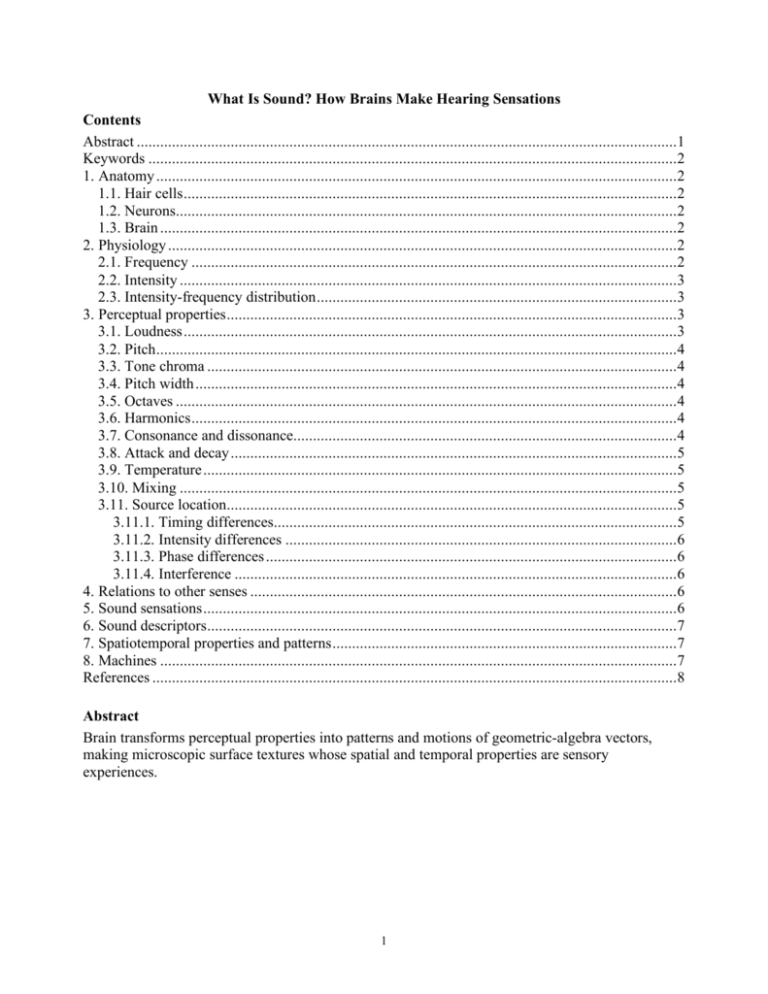
What Is Sound? How Brains Make Hearing Sensations
Contents
Abstract ..........................................................................................................................................1
Keywords .......................................................................................................................................2
1. Anatomy .....................................................................................................................................2
1.1. Hair cells..............................................................................................................................2
1.2. Neurons................................................................................................................................2
1.3. Brain ....................................................................................................................................2
2. Physiology ..................................................................................................................................2
2.1. Frequency ............................................................................................................................2
2.2. Intensity ...............................................................................................................................3
2.3. Intensity-frequency distribution............................................................................................3
3. Perceptual properties...................................................................................................................3
3.1. Loudness..............................................................................................................................3
3.2. Pitch.....................................................................................................................................4
3.3. Tone chroma ........................................................................................................................4
3.4. Pitch width...........................................................................................................................4
3.5. Octaves ................................................................................................................................4
3.6. Harmonics............................................................................................................................4
3.7. Consonance and dissonance..................................................................................................4
3.8. Attack and decay..................................................................................................................5
3.9. Temperature.........................................................................................................................5
3.10. Mixing ...............................................................................................................................5
3.11. Source location...................................................................................................................5
3.11.1. Timing differences.......................................................................................................5
3.11.2. Intensity differences ....................................................................................................6
3.11.3. Phase differences .........................................................................................................6
3.11.4. Interference .................................................................................................................6
4. Relations to other senses .............................................................................................................6
5. Sound sensations.........................................................................................................................6
6. Sound descriptors........................................................................................................................7
7. Spatiotemporal properties and patterns........................................................................................7
8. Machines ....................................................................................................................................7
References ......................................................................................................................................8
Abstract
Brain transforms perceptual properties into patterns and motions of geometric-algebra vectors,
making microscopic surface textures whose spatial and temporal properties are sensory
experiences.
1
Keywords
area A1, attack, auditory neuron, azimuth, belt area, binauralism, characteristic frequency, cochlea,
consonance, critical band, decay, dissonance, elevation, hair cell, harmonics,
head-related transfer function, high-spontaneous fiber, interaural level difference,
interaural time difference, lateral superior olive, loudness, low-spontaneous fiber,
medial superior olive, octave, offset, onset, organ of Corti, parabelt area, phase locking, pitch,
pitch width, place coding, place theory, superior olive, temporal code, temporal lobe,
temporal theory, tone, tone chroma, trapezoid-body medial nucleus, volley code, volley theory
1. Anatomy
Vibration receptors send to auditory neurons, which send to cortical regions.
1.1. Hair cells
Inner-ear cochlea hair cells have vibration receptors that detect 20 Hz to 20,000 Hz
compression-and-rarefaction longitudinal vibrations. The organ of Corti has 30,000 hair cells, with
hairs ranging from short to long.
1.2. Neurons
Auditory neurons receive input from 10 to 30 hair cells.
1.3. Brain
Forebrain temporal lobe has regions for hearing.
Cortical area A1 auditory neurons align from low to high frequency {tonotopic organization}.
The adjacent belt area receives from area A1 and responds to complex sound features.
The laterally adjacent parabelt area receives from the belt area and responds to complex sounds and
multisensory features.
Medial superior olive detects time differences between left-right ears and right-left ears. Lateral
superior olive detects intensity-level differences between left-right ears and right-left ears.
Opposite-ear output goes to trapezoid-body medial nucleus, which lies beside pons lateral superior
olive.
2. Physiology
Organ-of-Corti short hairs detect high frequencies, and long hairs detect low frequencies, so
hair-cell-activity spatial distribution indicates frequency {place coding} {place theory}.
Temporal-lobe neurons receive from hair cells and find sound loudness and pitch.
2.1. Frequency
Auditory neurons have a frequency {characteristic frequency} at which they are most sensitive. If
sound-wave frequency is above, or more than a quartertone below, characteristic frequency,
auditory neurons fire at baseline frequency.
At frequencies below 800 Hz to 900 Hz, one neuron can carry sound information, and sound wave
and neuron activity have same frequency {temporal theory} {temporal code}. Adjacent auditory
neurons fire at same phase {phase locking} and frequency, because adjacent hair cells link and so
push and pull at same time.
2
At 800 Hz, firing rate drops abruptly. From 800 Hz to 1600 Hz, at least two neurons carry sound
information, and sound wave and neuron activity have linearly related frequency. Auditory-neuron
subsets fire every other sound-wave cycle {volley theory} {volley code}. For example, one neuron
firing at 600 Hz starting in phase with sound-wave frequency, and the other neuron firing at 600 Hz
starting one sound-wave cycle later, can represent frequency 1200 Hz.
At 1600 Hz, firing rate drops abruptly. From 1600 Hz to 3000 Hz, at least three neurons carry
sound information, and sound wave and neuron activity have linearly related frequency.
Auditory-neuron subsets fire every third sound-wave cycle. For example, one neuron firing at 600
Hz starting in phase with sound-wave frequency, the second neuron firing at 600 Hz starting one
sound-wave cycle later, and the third neuron firing at 600 Hz starting two sound-wave cycles later,
can represent frequency 1800 Hz.
Above 3000 Hz, neuron sets respond to frequency, tone pattern, or intensity spectrum.
2.2. Intensity
Auditory neurons with the same characteristic frequency have three types.
Low-spontaneous fibers respond to high intensity of frequencies close to the characteristic
frequency. Firing rate starts at less than 10 per second and rises with intensity.
High-spontaneous fibers respond to low intensity of frequencies within a wide range of the
characteristic frequency. Firing rate starts at greater than 30 per second and rises with intensity
(with maximum at a low intensity).
Mid-spontaneous fibers respond to medium intensity of frequencies within a medium range of the
characteristic frequency. Firing rate starts at greater than 10 per second and rises to less than 30 per
second.
2.3. Intensity-frequency distribution
Auditory-nerve-fiber activity distribution represents frequency, frequency-range {critical band},
and intensity.
Hearing performs limited-resolution Fourier analysis on sound frequencies and intensities
[Friedmann, 1979]. Hearing perceptual processes [Kaas and Hackett, 2000] compare adjacent and
harmonic frequency intensities, and integrate over many neurons, to filter frequencies to find their
individual intensities.
3. Perceptual properties
People can detect loudness, pitch, tone chroma, pitch width, octaves, and harmonics. People can
distinguish one million sounds.
People can hear sound waves of frequency 20 Hz to 20,000 Hz. Human hearing is most sensitive at
frequency 1800 Hz. Above 5000 Hz, musical pitch is lost.
3.1. Loudness
Loudness relates to sound-wave relative intensity. People can distinguish 100 loudness levels.
3
3.2. Pitch
Pitch relates to sound-wave frequency. People easily distinguish tones and half tones, and can
distinguish quarter-tones (whose frequencies differ by several percent) after learning. People can
distinguish that a tone is slightly higher (sharp) or lower (flat) in frequency than another tone.
People can distinguish 120 pitches.
Sounds with many high-frequency components seem shrill, strident, harsh, shallow, and/or thin.
Tones with mostly low-frequency components seem dull, mellow, smooth, deep, and/or thick.
Full tones have many frequency resonances. Shallow tones have few frequency resonances.
3.3. Tone chroma
Tone chroma relates to sound-wave frequency range. Tones that share one octave have perceivable
sound features. People can distinguish 10 tone chroma.
3.4. Pitch width
Pitch width relates to sound-wave frequency-intensity distribution around a frequency. People can
distinguish 10 pitch widths. If all energy is at the frequency, pitch width is narrow. If energy is
mostly at frequencies within a percent of the frequency, pitch width is wide. If energy is mostly at
frequencies more than a percent of the frequency, pitch is lost, pitch width has no meaning, and
sound is noise.
Clear tones have narrow frequency band. Unclear tones have wide frequency band. Noise has many
frequencies.
3.5. Octaves
Two musical tones can have a frequency ratio expressible as 2^n, where n = -10 to +10. For
example, middle-C frequency is 256 Hz, and high-C frequency is 512 Hz, so frequency ratio is
2^-1 = 1/2 or 2^1 = 2.
Hearing covers ten octaves: 20 Hz, 40 Hz, 80 Hz, 160 Hz, 320 Hz, 640 Hz, 1280 Hz, 2560 Hz,
5120 Hz, 10240 Hz, and 20480 Hz.
Within one octave are 7 whole tones: A, B, C, D, E, F, and G. Within one octave are 7 + 5 = 12
halftones: A, B-flat, B, C, C-sharp, D, D-sharp, E, F, F-sharp, G, and G-sharp. Within one octave
are 24 quartertones.
3.6. Harmonics
Two musical tones can have a frequency ratio expressible using small integers. For example,
middle-C and high-C have frequency ratio 1:2. Middle-C and middle-G have frequency ratio 2:3.
Middle-G and high-C have frequency ratio 3:4.
Tone-frequency ratios of two tones within an octave are the same for all octaves. For example,
high-C and high-G have frequency ratio 2:3.
For the seven whole tones in an octave (C, D, E, F, G, A, B), frequency ratios are D/C = 9/8 (D#/C
= 6/5), E/C = 5/4, F/C = 4/3, G/C = 3/2, A/C = 5/3, and B/C = 11:6 or 15:8.
3.7. Consonance and dissonance
People hearing two tones report that they sound pleasingly consonant or less pleasingly dissonant.
Ratios with smallest integers in both numerator and denominator have consonance. Octaves are
most pleasing. Frequency ratios 3/2 and 4/3 are pleasing.
Frequency ratios 5/4 and 8/5 are halfway between consonant and dissonant. Frequency ratios 6/5
and 5/3 intervals are halfway between consonant and dissonant.
4
Ratios with larger integers in both numerator and denominator have dissonance. Frequency ratios
7/6 and 12/7 intervals are dissonant. Frequency ratios 8/7 and 7/4 intervals are more dissonant.
Frequency ratios 9/8 and 16/9 intervals are even more dissonant. Frequency ratios 16/15 and 15/8
intervals are most dissonant.
Tone ratios in octaves higher or lower than middle octave have same consonance or dissonance as
the corresponding tone ratio in the middle octave. For example, high-G and high-C have ratio 3/2,
the same as middle-G/middle-C.
Tone ratios between higher or lower octaves and middle octave have similar consonance as
corresponding tone ratio in middle octave. For example, high-G and middle-C have ratio 3/1.
Dividing by two makes high-G one octave lower, and middle-G/middle-C has ratio 3/2.
3.8. Attack and decay
Tones can rise quickly or slowly from background noise level to maximum intensity {attack}
{onset}. Fast onset sounds aggressive. Slow onset sounds peaceful.
Tones can fall slowly or rapidly from maximum to background noise level {decay} {offset}.
3.9. Temperature
Warm tones have longer and lower attack and decay, longer tones, and more harmonics. Cool tones
have shorter and higher attack and decay, shorter tones, and fewer harmonics.
3.10. Mixing
People can simultaneously hear different frequencies at different intensities. Sounds are
independent, so hearing is an analytic sense.
Sounds do not have opposites.
3.11. Source location
Hearing determines sound location separately and independently of perceiving tones.
Having two ears {binauralism} allows calculating time, intensity, and phase differences between
left-ear and right-ear sound streams, to locate sound source in space. Body and head, including
pinnae and ear canals, transmit and absorb different frequency, elevation, and azimuth sounds
differently {head-related transfer function}.
Hearing can calculate distance. Sound sources farther than 1000 meters have fewer high
frequencies, because of air damping.
Hearing can calculate angle to right or left, from straight-ahead to straight-behind, in horizontal
plane (azimuth).
Hearing can calculate height and angle above horizontal plane (elevation). People perceive lower
frequencies as slightly lower than actual elevation. People perceive higher frequencies as slightly
higher than actual elevation.
3.11.1. Timing differences
The same sound reaches right and left ear at different times {interaural time difference}, because
distances from source location to ears differ. Hearing can detect several microseconds of time
difference.
Medial superior olive detects time differences between left-right ears and right-left ears. To find
distances, two receptor outputs go to two different neurons, which both send to difference-finding
neuron, to make an opponent system.
5
Interaural time difference uses frequencies lower than 1500 Hz, because they have no body
damping.
Interaural time difference and interaural level difference work together to eliminate direction
ambiguity. Slight head movements can eliminate any remaining direction ambiguity.
3.11.2. Intensity differences
The same sound reaches right and left ear at different intensity levels {interaural level difference}.
Intensity difference reflects stimulus distance, approaching or receding sounds, and body sound
damping. Level difference can be as small as 1 dB.
Lateral superior olive detects intensity-level differences between left-right ears and right-left ears.
To find distance, two receptor outputs go to two different neurons, which both send to
difference-finding neuron, to make an opponent system.
Opposite-ear output goes to trapezoid-body medial nucleus, beside pons lateral superior olive,
which inhibits same-ear lateral-superior-olive output.
Intensity differences due only to sound distance, or to approaching or receding sounds, are useful
up to one or two meters (because, beyond two meters, differences are too small to detect).
Beyond one or two meters, hearing uses intensity differences of frequencies higher than 1500 Hz to
determine space directions and distances. Pinnae and head bones absorb sounds with frequencies
higher than 1500 Hz, according to their frequency-related dampening function. Pinnae and
head-bone damping differs on right and left, depending on source location.
Interaural time difference and interaural level difference work together to eliminate direction
ambiguity. Slight head movements can eliminate any remaining direction ambiguity.
3.11.3. Phase differences
People cannot hear phase differences, but hearing can use phase differences to locate sounds.
3.11.4. Interference
Hearing can detect more than one source and frequency from one location. Hearing can have
interference from more than one source.
4. Relations to other senses
Hearing, temperature, and touch involve mechanical energy.
Sound is fast vibration, while touch can have slow vibration. Sounds are longitudinal mechanical
vibrations. The lowest sound frequencies, 20 Hz to 30 Hz, are also the highest vibrations detectable
by touch. Below 20 Hz, people feel pressure changes as vibration, rather than hearing them as
sound. Sound vibrates eardrum and other body surfaces but is not felt as touch, unless very loud.
Vision and hearing share same perceptual space.
Noise sound and white color are similar in that they involve multiple frequencies.
5. Sound sensations
Hearing detects sound intensity, frequency, and frequency distribution.
Tones have categories but vary continuously over the frequency range.
Tones do not mix, and people can simultaneously hear different frequencies at different intensities.
Note 1: Sound waves are longitudinal waves, with compressions and rarefactions in air (or another
medium). Molecules oscillate as sound waves pass through the medium. Loudness depends on
compression pressure and so on the force that caused the original vibration. Media can carry waves
of many frequencies.
6
Note 2: Higher compression pressures give media molecules higher speeds but also proportionally
more distance, and molecule collisions are elastic collisions, so frequencies stay constant.
Note 3: Elastic collisions are very-high-speed electromagnetic interactions, so sound waves travel
so quickly that previous compressions do not interfere with later compressions.
Note 4: For the same wave frequency, greater amplitudes have higher amplitude-change rates. For
the same wave amplitude, higher frequencies have higher amplitude-change rates. For different
wave amplitudes, higher frequencies have higher ratios of amplitude-change rate to amplitude.
Therefore, the ratio of amplitude-change rate to amplitude indicates wave frequency, within a time
interval one-half wave period. Perhaps brain auditory systems use attack (or decay) to help find
sound frequency.
6. Sound descriptors
Hearing perceives sound duration, loudness (from intensity), attack and decay (from intensity),
pitch (from frequency), pitch width (from frequency distribution), tone chroma of tones in same
octave (from frequency distribution), and harmonics and consonance-dissonance (from frequency
distribution).
Low-frequency sounds can be dull, mellow, smooth, rounded, and/or thick. High-frequency sounds
can be shrill, strident, harsh, jagged, and/or thin.
Sounds with many frequency resonances sound full. Sounds with few frequency resonances sound
shallow.
Sounds with a narrow frequency band sound clear. Sounds with a wide frequency band sound
unclear. Sounds with many frequencies sound like noise.
Two similar tones can sound sharp or flat compared to each other.
Sounds with low frequency and no attack and decay have warm temperature. Sounds with high
frequency and attack and decay have cool temperature.
7. Spatiotemporal properties and patterns
Hearing perceptual-property spatiotemporal patterns are vibrations.
Sound sensations sound like vibrations.
Perhaps, sounds feel like they have a fundamental vibration, with different tones on that vibration,
like modulation of a fundamental frequency. The sound of fundamental vibration comes from the
feeling of mechanical vibration at 20 Hz to 30 Hz, which is like a hum. Higher frequencies sound
higher than the sound of the fundamental vibration because they are multiples of the fundamental
vibration, so they sound double, 3/2, and so on the fundamental sound. Therefore, the first sound
comes from mechanical flapping, and higher-frequency sounds sound like multiples of that sound,
and so sound higher.
Note: Perhaps sound sensations vibrate at a rate that is the logarithm of the actual vibration
frequency, and so along a linear scale from 1 to 120.
8. Machines
Machines can simulate sound sensations using a microscopic-surface-texture array with elements
that oscillate radially at the same frequency as the stimulus (or its logarithm). More elements
represent higher loudness.
7
References
Friedmann, Imrich (1979) The Human Ear. Burlington, NC: Carolina Biological Supply.
Kaas, Jon H.; and Hackett, Troy A. (2000) Subdivisions of auditory cortex and processing streams
in primates. Proceedings of the National Academy of Sciences USA, 97, 11793-11799.
Note: The Bibliography of Hearing, Sound, and Audition and the Consciousness Bibliography of
10,000 books and articles, with full journal and author names, is available in text and PDF file
formats at http://www.outline-of-knowledge.info/Consciousness_Bibliography/index.html.
Date: February 27, 2016
Copyright © 2014, 2015, 2016 John Franklin Moore. All rights reserved.
8

